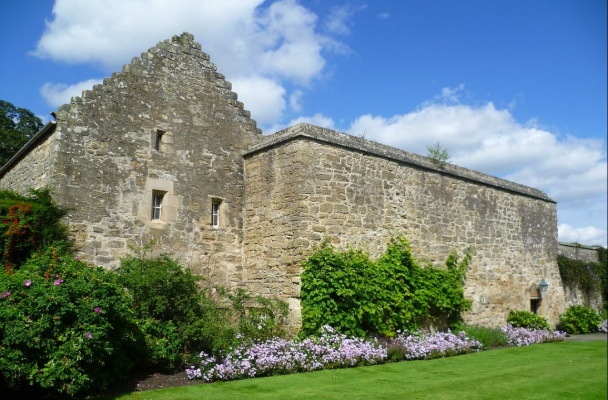“What was the significance of the number 4 in medieval France?”

The Real Tennis Court building at Falkland Palace in Fife, Scotland. This building is believed to be the world’s oldest tennis court. (Photo: Kim Traynor)
That tennis post I did last week keeps generating questions for those of us here at Caterpickles Central. Chasing down potential answers to them has proved surprisingly entertaining, so I thought I’d do a quick follow-up post this morning to share what we’ve learned so far.
After reading my post last week and gently reminding me about the other 300 degrees that make up both medieval and modern circles, my brother Paul noted that it seemed a little weird that the six sets in medieval tennis contained only four 60-degree games each. Mathematically speaking, if the goal was to represent the 360 degrees in a circle, it would have made more sense to have each set contain 6 games.
I had glossed over the 4 games-per set bit in my original explanation because it didn’t make sense to me either at the time. Even I know that 4 x 60 is only 240.
But glossing over medieval scoring tidbits is how I got into this mess in the first place, so I did a little digging about the meaning of the number 4 in medieval times.
What was so important about the number 4 anyway?
Turns out back then the number 4 represented the four corners of the Earth (among other things). Assuming that our astronomical explanation for the origin of tennis’ bizarre scoring pattern is correct, the 6 sets of 4 games each may have been designed to represent the orbits of the heavenly bodies around the four corners of the Earth. (Remember, back then they accepted Aristotle’s theory that the heavens rotated around the Earth, which remained fixed in the sky.)
Winning 6 four-game sets might have meant that your heavenly body had successfully completed its 360 orbit around the the Earth. Or maybe the simplest explanation really was the correct one — on average, medieval tennis players required 6 sets of 4 games each in order to collect enough degrees to complete their circle.
Alert readers will also note that this isn’t the only time the number 4 pops up in tennis scoring. Assuming all went well for the winner and he or she was able to avoid getting trapped in a deuce situation, tennis players earned their 60 degrees per game in 4 steps. Were those four steps meant to represent the four corners of the Earth as well? Or maybe just the four winds, as in this explanation is starting to sound like just so much wind.
Whatever the real reasons behind tennis’ bizarre scoring scheme may have been, this astronomical/numerological hypothesis sure is fun to think about.
Next week: “Did clocks even have minute hands in 12th C France?”
Related Links:
- “Why is tennis scoring so weird?” (Caterpickles)
- Medieval Numerology: A Brief Guide (Dr. Wheeler’s Website)
- Falkland Palace and Garden (The National Trust for Scotland)
- Jurassic Tennis (The Smart Set): What it’s like to play jeu de paume in Paris today

What are you thinking?